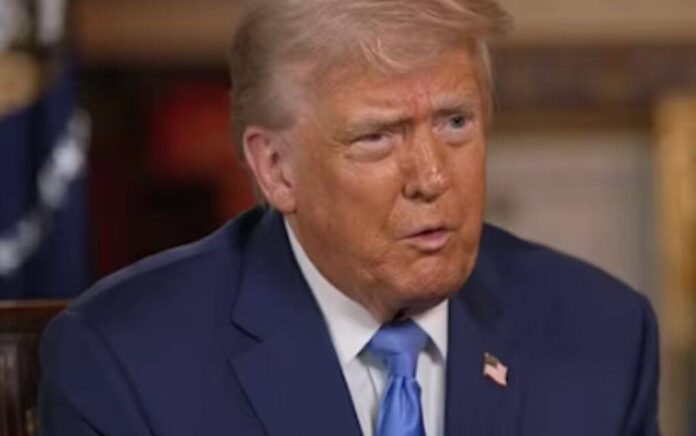
President Trump made a high-stakes gamble. The White House has waited with baited breath for the results.
And now a report has hit Trump’s desk that left all of the D.C. Swamp thunderstruck.
U.S. Records $27 Billion Budget Surplus in June
The U.S. government achieved a $27 billion budget surplus in June, driven significantly by a surge in tariff revenue, according to the Treasury Department’s latest figures released on Friday. The surplus was propelled by $27.2 billion in customs revenue, marking one of the highest monthly tariff collections in the past ten years. This increase stems from President Donald Trump’s recent policies imposing elevated tariffs on various countries to counter perceived imbalances in global trade practices.
Government spending also saw a notable decline, dropping by 27% from May’s $686 billion to $499 billion in June, the Treasury data revealed. This $27 billion surplus stands in stark contrast to the $316 billion deficit recorded the previous month.
According to CNBC, tariff collections for the year have reached $113 billion, an 86% increase compared to the same period last year. In April, Trump introduced broad “Liberation Day” tariffs targeting nearly all trading partners but later scaled them back to a 10% baseline rate for 90 days. The administration has also implemented new tariffs on steel, aluminum, and automobiles, with plans for additional duties on copper in the near future.
At a White House cabinet meeting on Tuesday, Treasury Secretary Scott Bessent forecasted that tariff revenue could reach $300 billion by the end of 2025. President Trump has consistently advocated tariffs as a means to correct trade imbalances and boost federal revenue, even proposing during his campaign that tariff income could potentially replace the income tax. The administration has signaled that further tariff hikes are planned for countries that do not reach trade agreements with the U.S. by August 1.
To date, only the United Kingdom, Vietnam, and China have finalized trade deals with the Trump administration. In recent weeks, Trump has notified several world leaders of impending tariff rates effective August 1 if no agreements are reached. Major trading partners, including South Korea and Japan, face potential 50% tariffs, while Canada could see a 35% rate.
The History of Budget Surpluses in Modern American History
Budget surpluses, where federal revenues exceed expenditures, are a rare occurrence in modern U.S. history. Since World War II, the U.S. government has typically operated at a deficit, with spending outpacing revenue due to economic cycles, wars, social programs, and tax policies. The June 2025 surplus of $27 billion, as reported by the Treasury Department, marks a significant milestone, particularly under President Donald Trump’s administration, which has leveraged tariffs to boost revenue while cutting spending.
The last sustained period of federal budget surpluses occurred between 1998 and 2001 under President Bill Clinton. These surpluses, ranging from $69 billion in 1998 to $236 billion in 2000, were driven by a booming economy, low unemployment, and fiscal restraint following the 1997 Balanced Budget Act. The dot-com boom and capital gains tax revenue played a significant role, but these surpluses quickly dissipated after 2001 due to tax cuts, the 9/11 attacks, and subsequent military spending.
Before the Clinton era, surpluses were even rarer. A brief surplus appeared in 1969 under President Richard Nixon, amounting to $3.2 billion, largely due to temporary economic growth and restrained federal spending. Prior to that, small surpluses occurred in 1956 and 1957 during the Eisenhower administration, fueled by post-Korean War economic stability. Since 1945, these instances—1969, 1957, 1956, and 1998–2001—represent the only years of federal budget surpluses.
The Trump administration’s achievement of a surplus in June 2025 is notable not only for its rarity but also for its reliance on tariff revenue, a policy tool rarely used to such an extent in modern times. The $27.2 billion in customs receipts for June reflects an 86% year-over-year increase in tariff collections, driven by Trump’s aggressive trade policies. These include the “Liberation Day” tariffs announced in April 2025, which initially targeted nearly all trading partners before being moderated to a 10% baseline rate for 90 days.
Historically, tariffs have not been a primary driver of federal revenue since the early 20th century, when income taxes became the dominant revenue source following the 16th Amendment in 1913. The Smoot-Hawley Tariff Act of 1930, which raised tariffs significantly, led to a collapse in global trade and exacerbated the Great Depression, making tariffs a less favored tool for decades. Trump’s revival of tariffs as a fiscal strategy marks a departure from this trend, aiming to both generate revenue and address trade imbalances.
The June 2025 surplus also benefited from a 27% reduction in federal spending compared to May, dropping from $686 billion to $499 billion. This reduction is a part of Trump’s fiscal agenda, which emphasizes deregulation and targeted spending cuts. However, sustaining surpluses remains challenging, as historical data shows deficits often return with economic downturns or policy shifts, such as the Bush tax cuts and increased defense spending post-2001.
Trump’s tariff strategy has sparked debate. Proponents argue it strengthens domestic industries and boosts revenue, while critics warn of higher consumer prices and potential trade wars, as seen in the 1930s. The administration’s success in securing trade deals with the UK, Vietnam, and China by July 2025 suggests some diplomatic progress, but looming tariff hikes on countries like South Korea (50%), Japan (50%), and Canada (35%) could strain relations if agreements are not reached by August 1.
Looking forward, Treasury Secretary Scott Bessent’s projection of $300 billion in tariff revenue by the end of 2025 indicates confidence in this approach. However, historical surpluses have been fleeting, often undone by unforeseen events like recessions or policy changes. The Congressional Budget Office notes that deficits have averaged 3.5% of GDP since 1970, with surpluses occurring in less than 5% of fiscal years, highlighting the extraordinary nature of the 2025 surplus.



















